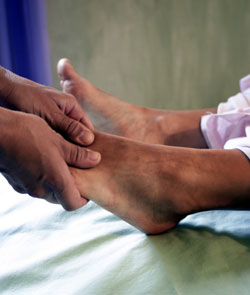About one-third of doctors and their patients with diabetes do not see eye to eye on the most important health conditions to manage, according to a survey by the University of Michigan Medical School.
While both groups frequently ranked diabetes and hypertension among their top concerns, 38 percent of doctors were more likely to rank hypertension as the most important, while only 18 percent of diabetics said it was the most important. Patients were also more likely to prioritize symptoms such as pain and depression.
The findings appear in the current issue of the Journal of General Internal Medicine and may shed light on why some patients manage their diabetes so poorly.
"If a patient and their doctor do not agree on which of these issues should be prioritized, it will be difficult for them to come up with an effective treatment plan together," says lead author Donna M. Zulman, M.D., a Robert Wood Johnson Clinical Scholar at the University of Michigan Medical School and researcher at the Veterans Affairs Healthcare System in Ann Arbor.
When a diabetic patient visits the doctor, the doctor is often concerned about the patient's risk of long-term complications from high blood sugar or uncontrolled sugar such as heart disease or kidney disease. The patient, however, might have more pressing issues, such as back pain or depression.
Continue Reading Below ↓↓↓
"Both sets of priorities are valid, however we know from previous studies that issues like pain interfere with a person's ability to manage their diabetes," Zulman says. "So putting these types of symptomatic problems on the back-burner might lead to worse outcomes in diabetes and other chronic conditions."
On average adults with diabetes have at least three other chronic health conditions. It means their doctors face the challenge of addressing multiple complex conditions in a brief office visit.
Researchers at U-M and Veterans Affairs surveyed 92 doctors and their nearly 1,200 patients who had diabetes and hypertension. Of the 714 pairs, 28 percent did not prioritize health conditions the same way. The discord was strongest among the sickest patients.
"One possible explanation for this is that patients with poor health or competing demands may be more likely to face functional limitations, financial stress, and other barriers to care," she said. "For these patients, symptomatic problems might be of utmost importance because they exacerbate their existing challenges."
An estimated 18 million people in the U.S. have diabetes and another 5.7 million are undiagnosed. The number has nearly tripled since 1980 and people over age 65 account for 37 percent of all cases, according to the U.S. Centers for Disease Control and Prevention.
Additional authors: Eve A. Kerr, M.D., MPH; Timothy P. Hofer, M.D., M.S., Robert Wood Johnson Clinical Scholar Mary Ellen Michele Heisler, M.D. and Brian J. Zikmund-Fisher, all of the U-M Department of Internal Medicine and Department of Veteran Affairs Health Services Research and Development Center of Excellence.
Source: University of Michigan










